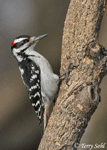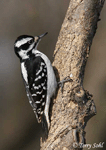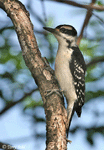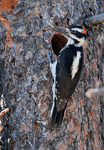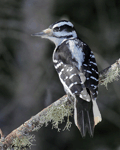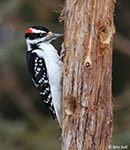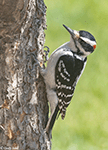| Length: 8.5 to 10.5 inches | Wingspan: 15 to 18 inches | Seasonality: All Seasons |
| ID Keys: Size, bill nearly as long as head is deep, white outer tail feathers lacking spots, bold call | ||
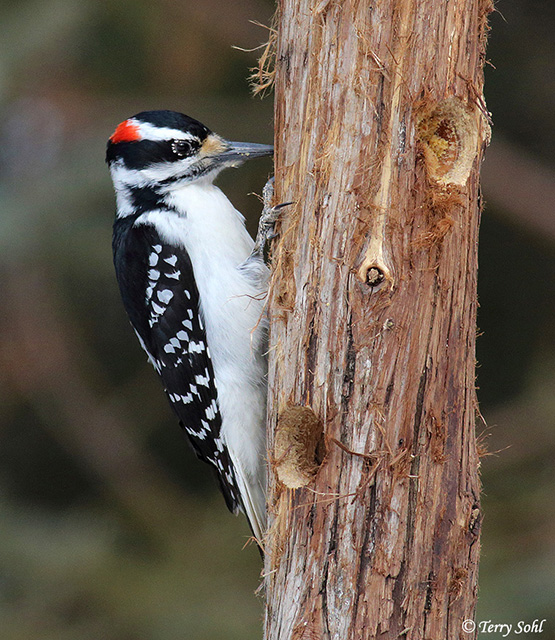 The Hairy Woodpecker is very similar to the
Downy Woodpecker, which has a
smaller size and shorter bill. The Hairy Woodpecker tends to be less
common, shyer, and more restricted to areas with large trees than it's smaller
cousin. Both are permanent residents in South Dakota. Males
(pictured at the right) have a red patch on the back of their heads, while
females do not.
The Hairy Woodpecker is very similar to the
Downy Woodpecker, which has a
smaller size and shorter bill. The Hairy Woodpecker tends to be less
common, shyer, and more restricted to areas with large trees than it's smaller
cousin. Both are permanent residents in South Dakota. Males
(pictured at the right) have a red patch on the back of their heads, while
females do not.
Habitat:
Will use a wide variety of habitats including forests, woodlands, residential areas, and riparian areas, but typically requires large trees to be present.
Diet:
Mostly insects. Also eats some seeds and berries, as well as nuts and suet at feeders.
Behavior:
Actively forages on the trunks and branches of trees. They will also sometimes forage in bushes and other vegetation. They are much more likely to excavate and peel bark from trees than are the smaller Downy Woodpeckers. Hairy Woodpeckers are also sometimes opportunists, taking advantage of other woodpecker species. They have frequently been observed visiting sap wells from various Sapsucker species (several Sapsucker species are found across their range), and both drinking sap and capturing the insects stuck in the sap. They also have been observed following Pileated Woodpeckers, searching through recently flaked off bark and excavation holes in trees in search of insects the Pileated Woodpecker may have missed.
Nesting:
The nest of a Hairy Woodpecker is a cavity excated in a tree, made by both the male and female. The female lays between 3 and 6 eggs, with the male incubating the eggs at night and the female incubating them during the day. The eggs hatch in about 2 weeks, with both parents helping to feed the young. The young fledge after about 4 weeks, but the parents continue to feed them for a time after fledging,
Song:
The most frequent vocalization of a Hairy Woodpecker is a sharp peek call. They also have a dry rattling call, and drumming sounds. Less often a kweek call is given.
- Click here to hear a kweek call of a Hairy Woodpecker1
- Click here to hear the common peek call of a Hairy Woodpecker2
- Click here to hear the drumming call of a Hairy Woodpecker3
- Click here to hear the rattling call of a Hairy Woodpecker4
Migration:
Generally a permanent resident throughout its range, although there are indications that some birds at the far northern edge of the range may move south in the winter.
Interactive eBird Map:
Click here to access an interactive eBird map of Hairy Woodpecker sightings
Similar Species:
Hairy Woodpeckers are extremely similar in appearance to Downy Woodpeckers, but could also potentially be confused with other woodpecker species:
- Downy Woodpecker - Downy Woodpeckers are smaller cousins of the Hairy Woodpecker, and have just as broad a range across North America. They are both often found in the same habitats as well. Size is quite different between the two species, and a birder can become "calibrated" to judge the size alone to differentiate between the two. However, when seeing a lone bird, it can be difficult to use size alone. The bill length is the other obvious difference, as the bill of a Downy Woodpecker is noticeably smaller than that of a Hairy Woodpecker. Behavior is one more clue, as Downy Woodpeckers are often much more approachable than the more wary Hairy Woodpecker. For a comparison between the two species, look at this Comparison Chart.
- Yellow-bellied Sapsucker - Yellow-bellied Sapsuckers are another species that are found in South Dakota, although they're primarily found in the eastern part of the state and are increasingly rare as you move westward. Both male and female Yellow-bellied Sapsuckers have a bold white wing patch that separates them from Hairy Woodpeckers, as well as a red patch on the top of the head. Male Yellow-bellied Sapsuckers have a red throat patch lacking on a Hairy Woodpecker, while all Yellow-bellied Sapsuckers lack the red patch on the nape that's found on male Hairy Woodpeckers.
- Red-naped Sapsucker - Red-naped Sapsuckers are western North America's ecological equivalent of eastern North America's Yellow-bellied Sapsucker. They can be found in the Black Hills of South Dakota, where they may be in the same areas as Hairy Woodpeckers. The identification keys listed above for Yellow-naped Sapsucker all hold for Red-naped Sapsuckers. The one exception is that male Red-naped Sapsuckers DO have a red nape patch (as do male Hairy Woodpeckers).
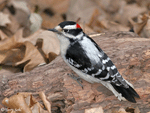 |
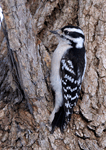 |
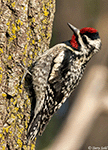 |
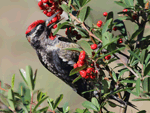 |
| Downy Woodpecker | Downy Woodpecker | Yellow-bellied Sapsucker | Red-naped Sapsucker |
Bird Feeder:
Sunflower seeds, nuts, suet, peanut butter.
Conservation Status:
Widely distributed and common, but numbers are likely below historical levels in many areas due to loss of habitat. However, systematic surveys over the last few decades indicate modest increases in populations. The IUCN considers the Hairy Woodpecker to be a species of "Least Concern".
Further Information:
Photo Information:
February 4th, 2006 - Perry Nature Area near Sioux Falls, South Dakota - Terry Sohl
Additional Photos:
Click on the image chips or text links below for additional, higher-resolution Hairy Woodpecker photos.
Audio File Credits:
- 1Ed Pandolfino. Recorded in Siskiyou County, California on April 21st, 2015. Original recording and information available from xeno-canto.
- 2Molly Jacobson. Recorded in Hillsborough County, New Hampshire on December 14th, 2018. Original recording and information available from xeno-canto.
- 3Richard E. Webster. Recorded in Chiapas, Mexico on March 23rd, 2013. Original recording and information available from xeno-canto.
- 4Don Jones. Recorded in Lake Willoughby area of Vermont on July 15th, 2002. Original recording and information available from xeno-canto.
| Click on the map below for a higher-resolution view |
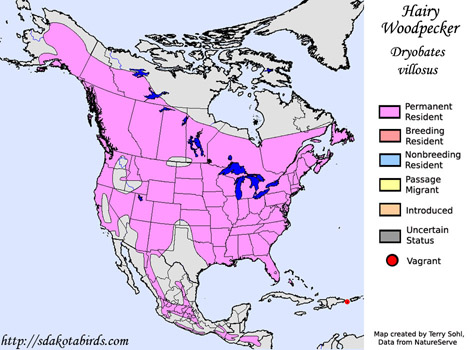 |
| South Dakota Status: Uncommon permanent resident throughout the state. |
Additional Hairy Woodpecker Photos
Click for a higher-resolution version of these photos
